Java语言内置多线程支持:
- 创建线程需要操作系统资源(线程资源,栈空间)
- 频繁创建和销毁线程需要消耗大量时间
如果可以复用一个线程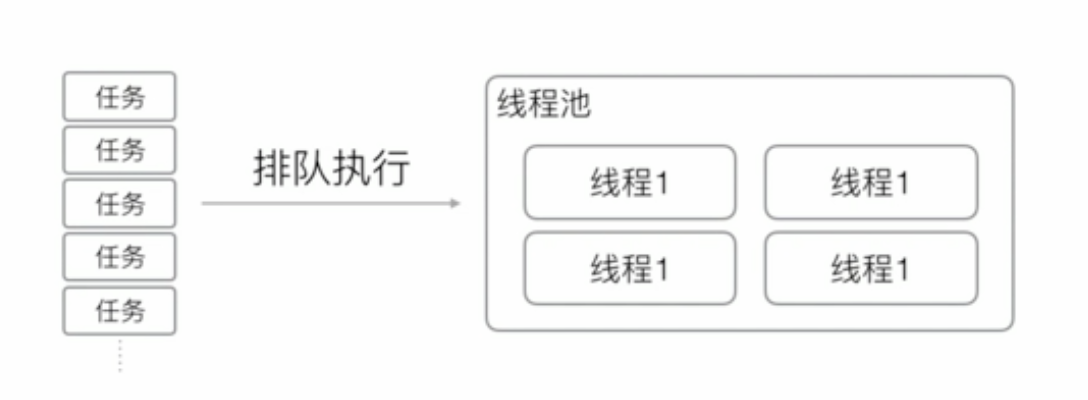
线程池:
- 线程池维护若干个线程,处于等待状态
- 如果有新任务,就分配一个空闲线程执行
- 如果所有线程都处于忙碌状态,新任务放入队列等待
ExecutorService
JDK提供了ExecutorService接口表示线程池:
ExecutorService executor = Executors.newFixedThreadPool(4); //固定大小的线程池 executor.submit(task1); //提交任务到线程池 executor.submit(task2); executor.submit(task3)
常用的ExecutorService:
- FixedThreadPool:线程数固定
- CachedThreadPool:线程数根据任务动态调整
- SingleThreadExecutor:仅单线程执行
import java.util.concurrent.ExecutorService; import java.util.concurrent.Executors; class PrintTask implements Runnable{ String name; public PrintTask(String name){ this.name = name; } public void run(){ for(int i=0;i<3;i++){ System.out.println(i+" Hello,"+name+"!"); try{ Thread.sleep(1000); }catch (InterruptedException e){} } } } public class ThreadPool { public static void main(String[] args) throws InterruptedException{ ExecutorService executor = Executors.newFixedThreadPool(3); //指定线程数为3 executor.submit(new PrintTask("Bob")); executor.submit(new PrintTask("Alice")); executor.submit(new PrintTask("Tim")); executor.submit(new PrintTask("Robot")); Thread.sleep(10000); executor.shutdown(); //结束线程池 } } 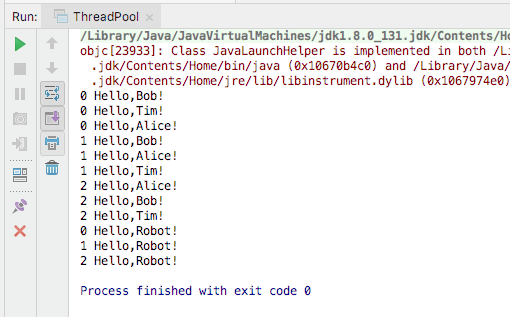
//单个线程 ExecutorService executor = Executors.newSingleThreadExecutor();
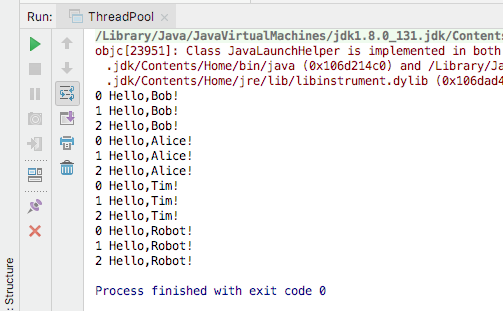
//动态调整的线程池 ExecutorService executor = Executors.newCachedThreadPool();
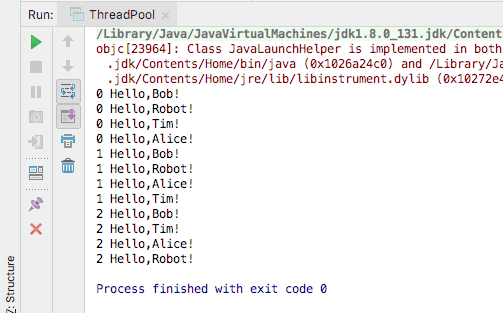
查看newCachedThreadPool源码,发现其实现的是ThreadPoolExecutor的构造方法,
public static ExecutorService newCachedThreadPool() { return new ThreadPoolExecutor(0, //初始化线程池的大小 Integer.MAX_VALUE,//线程池的最大值 60L, TimeUnit.SECONDS, new SynchronousQueue<Runnable>()); } //设置最大数量为10的动态线程池 ExecutorService executor = new ThreadPoolExecutor(0, 10, 60L, TimeUnit.SECONDS, new SynchronousQueue<Runnable>());
执行模式:
- Fixed Rate:固定的间隔,任务就会执行。例如每隔3秒任务就会启动,而不管这个任务执行多长、是否结束
- Fixed Delay:当任务执行完毕以后,等待1秒钟再继续执行。无论任务执行多久,只有在任务结束以后,等待1秒钟才会开始执行下一次的任务。
注意:ScheduledExecutorService不会自动停止
import java.time.LocalTime; import java.util.concurrent.Executors; import java.util.concurrent.ScheduledExecutorService; import java.util.concurrent.TimeUnit; class HelloTask implements Runnable{ String name; public HelloTask(String name){ this.name = name; } public void run(){ System.out.println("Hello,"+name+" ! It is "+LocalTime.now()); try{ Thread.sleep(1000); }catch (InterruptedException e){} System.out.println("Goodbye, "+name+"! It is "+LocalTime.now()); } } public class SchedulePool { public static void main(String[] args) throws Exception{ ScheduledExecutorService executor = Executors.newScheduledThreadPool(3); executor.scheduleAtFixedRate(new HelloTask("Bob"),2,5,TimeUnit.SECONDS); executor.scheduleWithFixedDelay(new HelloTask("Alice"),2,5,TimeUnit.SECONDS); } } 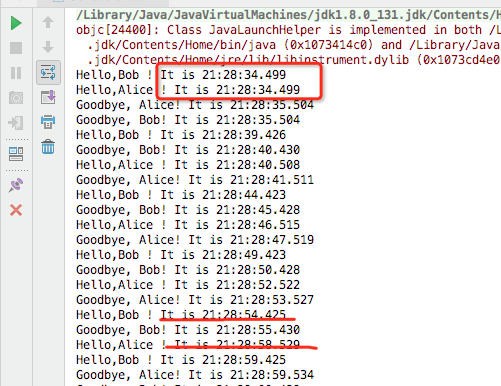
Bob的执行频率比Alice高的多,任务开始的时间差也越来越大
问题:
1.FixedRate模式下,如果任务执行时间过长,后续任务会不会并发执行?
不会
import java.time.LocalTime; import java.util.concurrent.Executors; import java.util.concurrent.ScheduledExecutorService; import java.util.concurrent.TimeUnit; class HelloTask implements Runnable{ String name; public HelloTask(String name){ this.name = name; } public void run(){ System.out.println("Hello,"+name+" ! It is "+LocalTime.now()); try{ Thread.sleep(10000); }catch (InterruptedException e){} System.out.println("Goodbye, "+name+"! It is "+LocalTime.now()); } } public class SchedulePool { public static void main(String[] args) throws Exception{ ScheduledExecutorService executor = Executors.newScheduledThreadPool(3); executor.scheduleAtFixedRate(new HelloTask("Bob"),2,1,TimeUnit.SECONDS); } } 
2.如果任务抛出了异常,后续任务是否继续执行?
不会
import java.time.LocalTime; import java.util.concurrent.Executors; import java.util.concurrent.ScheduledExecutorService; import java.util.concurrent.TimeUnit; class HelloTask implements Runnable{ String name; int count; public HelloTask(String name,int count){ this.name = name; this.count = count; } public void run(){ System.out.println("Hello,"+name+" ! It is "+LocalTime.now()+" "+count); try{ if(count == 3){ throw new RuntimeException("我是故意的"); } Thread.sleep(1000); }catch (InterruptedException e){} System.out.println("Goodbye, "+name+"! It is "+LocalTime.now()); count++; } } public class SchedulePool { public static void main(String[] args) throws Exception{ ScheduledExecutorService executor = Executors.newScheduledThreadPool(3); executor.scheduleAtFixedRate(new HelloTask("Bob",0),2,5,TimeUnit.SECONDS); } } 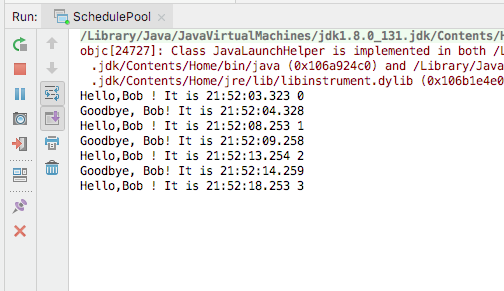
- 一个Timer对应一个Thread,只能定期执行一个任务。如果要执行多个定时任务,就必须要启动多个Timer。
- 必须在主线程结束时跳用Timer.cancel()
而一个ScheduledPool就可以调度多个任务,所以完全可以用新的Scheduled取代Timer类。
- JDK提供了ExecutorService实现了线程池功能
- 线程池内部维护一组线程,可以搞笑执行大量小任务
- Executors提供了静态方法创建不同类型的ExecutorService
- 必须调用shutdown()关闭ExecutorService
- ScheduledThreadPool可以定期调度多个任务